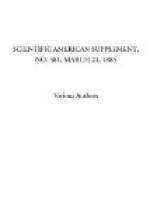Referring to the clepsydra, or water clock, described and illustrated in the scientific American supplement of December 20, 1884, it strikes me that the ingenious principle embodied in that interesting device could be put into a shape more modern and practical, doing away with some of its defects and insuring a greater degree of accuracy.
[Illustration: Fig 1.]
I would propose the construction given in the subjoined sketch, viz.: The drum, A (Figs. 1 and 3), is mounted in a yoke suspended in such a manner as to bring no unnecessary, but still sufficient, pressure on the friction roller, B, to cause it to revolve the friction cone, C (both cone and roller being of wood and, say, well rubbed with resin so as to increase adhesion).
[Illustration: Fig 2.]
The friction roller should be movable (on a screw thread), but so arranged that it can be fixed at any point, say by a lock nut, screw, clamp, or other simple means. It will be evident that, by shifting the roller, a greater or less speed of the cone can be effected, and as to the end of the cone’s axis an index hand sweeping an ordinary clock face is attached, the speed of this index hand can be regulated to a nicety, in proportion to that of the drum. Of course, before fixing the size and proportion of the disk and cone, the number of revolutions of the drum in a given time must be ascertained by experiment. For instance, the drum being found to make 15 revolutions in 12 hours, the proportions would be:
Circumference of roller = 12 units.
Circumference of middle part of cone = 15 units.
Or, the drum making 21/2 revolutions in 3 hours, equal to 9 revolutions in 12 hours:
Circumference of roller = 12 units.
Circumference of middle part of cone = 9 units.
Any slight inaccuracy can be compensated by the cone and disk device.
The drum, or cylinder, is caused to gradually revolve by a weight attached to an endless cord passing once around the drum. The latter might be varnished to prevent slipping. The weight should be provided with an automatic wedge, allowing it to be slipped along the cord in an upward direction, but preventing its descent. The weight is represented partly in section in the engraving. This weight should not be quite sufficient to revolve the drum, it being counterbalanced by the liquid raised in the chambers of the drum. The liquid, however, following its tendency to seek the lowest level, gradually runs back through the small hole, D, in the partitions, but is continually raised again, with the chamber it has just entered, by the weight slightly turning the cylinder as it (the weight) gradually gains advantage over the as gradually diminishing weight of each chamber raised.




